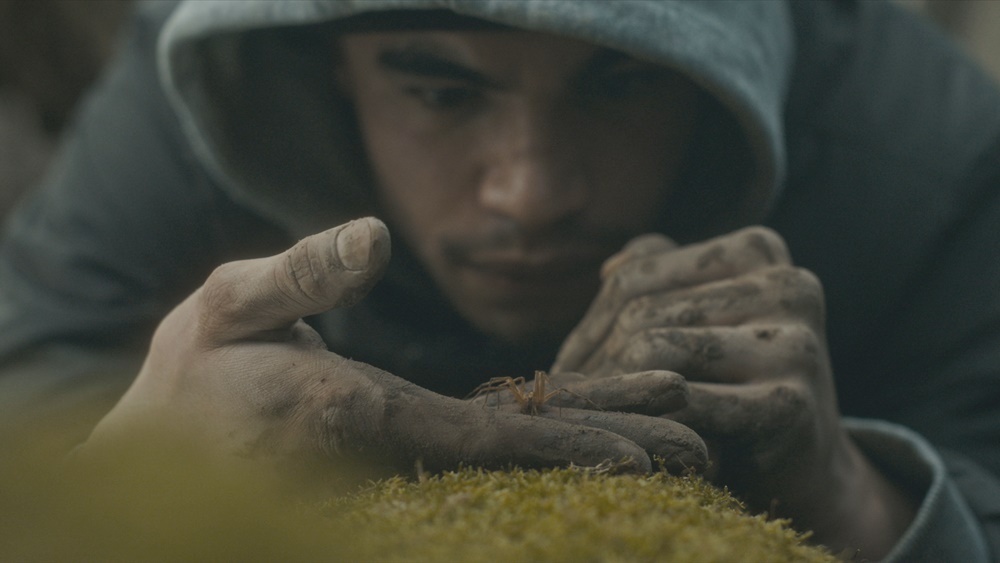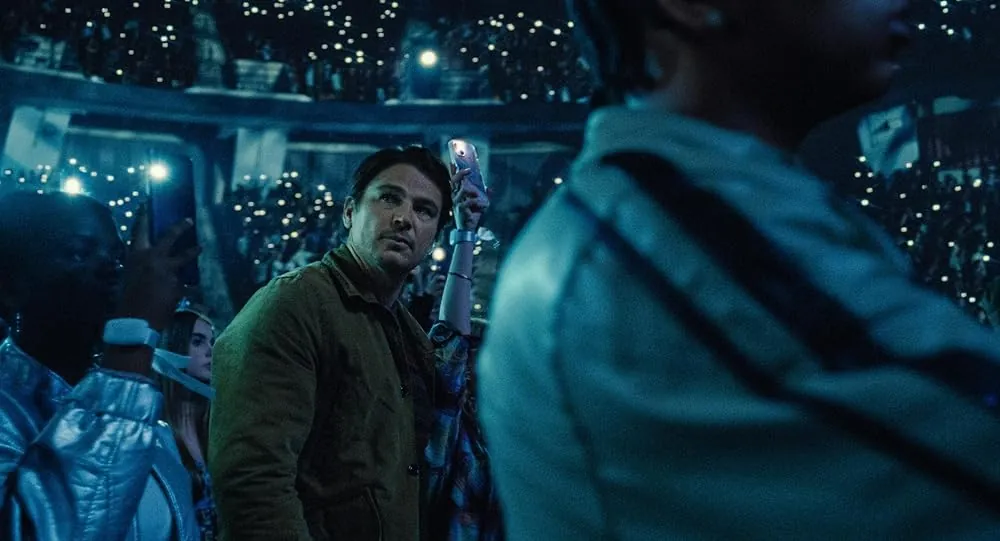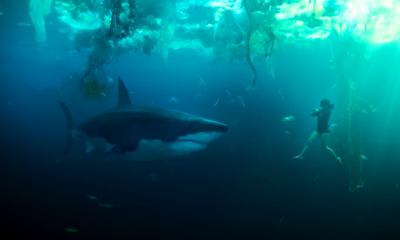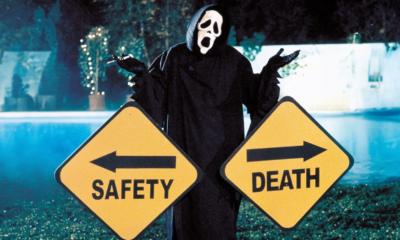News
iHorror Talks Apes & Cinema With Award-Winning Gurus Dan Lemmon & Gino Acevedo

Dan Lemmon. Photo by Frazer Harrison – 2015 Getty Images – Image courtesy gettyimages.com & IMDb.com
Interview With Award Winning Weta Visual Effects Supervisor Dan Lemmon
Ryan T. Cusick: Hey Dan! How are you?
Dan Lemmon: I am good, how are you?
RTC: I am doing pretty good, thanks for taking my call. Can you tell me what your background was before you were involved with digital effects?
DL: I was a student before, and I grew up loving movies especially Sci-Fi, Action effects kind of movies. Movies of all kinds. When I was a kid I did not get a chance to go to the movies much, my family didn’t have a lot of money. During the summer time, they had a program, and you can go and buy a book of movie tickets, I think it was basically a way to keep the kids occupied. Myself along with a few of the neighborhood kids would go down to the theater, and there would be all kinds of different screenings, some better than others. Every once in awhile you would get The Goonies, or E.T., some of those hallmark classic movies from the 80s’. Indiana Jones was another, and that film was a controversial one for me because my parents didn’t want me watching it but we snuck in and saw it anyway [Laughs].
RTC: That is awesome! I love hearing stories like that. [Laughs]
DL: It was a really special thing when we got to see a movie. When I got into high school, I had a friend that felt the same way. On the weekends we would spend our time making our short little films with our 8mm video camera. My friend had a little sound mixing desk that we would use, and he went on to become an animator, he was a really talented artist. He was an animator and storyboard artist on The Simpsons for years and years, and I am over here in New Zealand making visual effects.
RTC: Was there ever any movie that ever “spoke,” to you and you said to yourself, ‘This is what I want to do?”
DL: I was crazy about Star Wars just like about every other boy my age. I was pretty young when Empire came out. I had seen Empire and the original on VHS at slumber parties. I can remember when Jedi came out. For like a year leading up to the release that is all my friends and I could talk about, Return of The Jedi and we were so excited when it first came out. It was the coolest thing ever; there was no disappointment I did not feel let down at all, I enjoyed every minute of it, that was a big one. As I got a little bit older and I was in high school, two films had a significant impact. One was Terminator 2; I was a big Stan Winston fan already. When Terminator 2 came out that was game changing in terms of the marriage of practical effects and these new digital effects; it was just mind boggling the imagery that was created. The next year was Jurassic Park, and that was the film for me that made me say “that is what I want to do.” All I wanted to do was to make creatures.
RTC: I can remember seeing Jurassic Park for the first time, I was like twelve or thirteen, and seeing the 1st dinosaur on screen was just amazing, and definitely a game changer.
DL: Yes, [Excitingly] and with the John Williams score, the film opens up and you are dropped into this meadowy area, and then there is a giant reveal, and there are brontosauruses and they’re just there, and it doesn’t look like stop motion. You look back on the film now, and you can see a few things that you would do differently with the advanced technology, but I still think so much of it holds up so well.
RTC: I agree and the same with Terminator 2 it is a timeless piece, and I think it holds up just as well.
DL: I think that there is some charm to the rough edges, I love Ghostbusters and the way that you can put a story together, using the tools that they had available as long as the execution within that framework is competent. There is a certain amount of disbelief that you have walking into a theater anyway, sitting in a dark room with a bunch of other people pretending it is real life, even if it is theater, the sets aren’t real and time is compressed, there are just a lot of things that you accept. I think that with effects the bar continues to get raised higher and higher, there is less that the audience has to fill in with their mind. In some ways, a really good story-teller uses the audience’s minds to fill in the blank. How many times have you watched a monster movie and you have been totally hooked and then when the monster is revealed it turns out to be utterly disappointing? Something happens inside your head that in some ways is so much richer and more evocative than explicitly painting the whole picture and I think those are the hallmarks of a terrific storyteller is to leave those gaps and have the audience to ask good questions and to fill in the blanks themselves.
RTC: Most definitely. You are right; storytelling does revolve around letting the person watching the film create the monster in their mind, and yeah I have been disappointed before [Laughs]. For Planet of The Apes can you explain the process of capturing an actor’s performance and then replacing him or her with an Ape?

War for the Planet of the Apes (2017) Courtesy of 20th Century Fox & bnlmag.com

War for the Planet of the Apes (2017) Courtesy of 20th Century Fox & bnlmag.com
DL: Yeah, the idea in many ways is similar to a traditional prosthetic creature. You are using an actor to drive a character, and you are just changing the appearance of an actor. This is one of the things that we set out to do when making Planet of the Apes; it was a tradition that we really wanted to honor with the original 1968 Planet of the Apes. John Chambers, he won an award for makeup before there was even an Academy Award for makeup, they invented a special category just for his work on that movie. It wasn’t until about thirteen years later that they officially made a makeup category, so that is pretty remarkable. The idea that you take an actor like Roddy McDowall you put him in a chair and you apply prosthetics and appliances and extensive makeup, and suddenly they would be changed into this creature that does not look anything like Roddy McDowall. It has its own appearance that the audience will respond to differently than they would if it was a human actor. The more that he looks like an Ape, the more of a response from the audience. We definitely want to honor that tradition. One of the challenges, when we set out to make the first movie Rise it, was intended to be an origin story it aimed to tell the story of where these super intelligent apes came from. At the beginning of the movie, they had to appear indistinguishable from the apes that you would see in a documentary or zoo. Unfortunately with humans in a suite even with the best makeup, it is tough to get them to look 100% real. The body proportions of chimpanzees and humans are so different. Chimpanzees arms are so much longer, and their legs are so much shorter, and the way that the head is attached to the torso and just the physical strength and the proportions of the rest of the body is so much different we thought we could make them much more realistic by creating the characters digitally. We still wanted actors to drive those characters, and it was something that we had a lot of success with in the past with Andy Serkis in creating Gollum. He brought so much to that role. If he had been just doing the voice in a booth, it would have been an entirely different thing. Having an actor present in the scene, working with the other actors to refine the scene, working with the director to refine the performances everybody just does a better job when you can get everyone in the room acting with each other at the same time.
Through Lord of the Rings, King Kong, and especially Avatar we used this technology called motion capture and then we kind of extended it to where we call it performance capture, which is recording everything that an actor does with their body and does with their face as they do it and then taking that recording and applying it to a digital character. Normally it happens with a dedicated place, basically like a sound stage, you’ve got a lot of equipment, banks of computers, you’ve got sixty cameras or so – special motion capture cameras that only see invisible infrared light. You rig up the actors in a way that they have little dots, they are reflective dots and those little reflectors reflect infrared lights from the cameras back to the cameras. The cameras see little white dots moving around on the black background and all the cameras compare what it knows about all of the white dots on the black background and the computer reconstructs dots moving in 3D space.
Through a process, we take a puppet that we have built that matches the actor’s portions and we fit that puppet to those dots, so now we have a digital puppet of the actor moving around the same way that those dots are moving. There is also a process called retargeting where we take that actors movement on their puppet and we apply it to a puppet that matches the character that they are playing. In the case of Caesar Andy Serkis’s movement on the puppet and we are applying it to the Caesar puppet that has longer arms and shorter legs, and that is what the retargeting process is all about.

War for the Planet of the Apes (2017) Courtesy of 20th Century Fox & bnlmag.com

War for the Planet of the Apes (2017) Courtesy of 20th Century Fox & bnlmag.com
There is a certain movement that we do not pick up that is part of the performance capture process, like finger and toe animation, that stuff we have to add in manually, keyframe it. There is a lot of editing that the animators often have to do in order to refine the data and make it look 100% correct. Facial animation is a huge thing, we have some tools that help analyze. We paint this funny little dots on the actor’s face along with a little camera that attaches to their helmet and it records how those dots move around. The computer can only give us so much information on what those dots mean in terms of facial expression and it requires those trained eyes and hands of facial animators to go in and dial in those particular facial expressions and make them look as much like Andy Serkis doing his acting on that day. That is a real skill and that is something those girls and guys get better and better at as they do more and more of that kind of work.
On The Planet of the Apes movies we wanted to move off of the dedicated sound stage and take that technology on location out onto a working movie set and that was a whole other engineering and procedural pipeline figuring out process where we had to figure out how to take a system that normally fits into a giant room with lots and lot of computers that can take up to several weeks to setup and we had to figure out how to make it portable and set it up on a working movie set in a manner of 15-20 minutes.
RTC: That is amazing. How many people were on your team?
DL: On a large capture day we probably have about 30 crew on set. I would say half a dozen of those are our common visual effects presence. We’ve got data wranglers, reference photographers, myself as visual effects supervisor, producers, a few of these traditional roles.
RTC: Thank you so much for speaking with me today it was truly a pleasure, and I hope that we can do it again in the future.
DL: The pleasure was all mine.
Listen to the 'Eye On Horror Podcast'

Movies
Another Creepy Spider Movie Hits Shudder This Month

Good spider films are a theme this year. First, we had Sting and then there was Infested. The former is still in theaters and the latter is coming to Shudder starting April 26.
Infested has been getting some good reviews. People are saying that it’s not only a great creature feature but also a social commentary on racism in France.
According to IMDb: Writer/director Sébastien Vanicek was looking for ideas around the discrimination faced by black and Arab-looking people in France, and that led him to spiders, which are rarely welcome in homes; whenever they’re spotted, they’re swatted. As everyone in the story (people and spiders) is treated like vermin by society, the title came to him naturally.
Shudder has become the gold standard for streaming horror content. Since 2016, the service has been offering fans an expansive library of genre movies. in 2017, they began to stream exclusive content.
Since then Shudder has become a powerhouse in the film festival circuit, buying distribution rights to movies, or just producing some of their own. Just like Netflix, they give a film a short theatrical run before adding it to their library exclusively for subscribers.
Late Night With the Devil is a great example. It was released theatrically on March 22 and will begin streaming on the platform starting April 19.
While not getting the same buzz as Late Night, Infested is a festival favorite and many have said if you suffer from arachnophobia, you might want to take heed before watching it.
According to the synopsis, our main character, Kalib is turning 30 and dealing with some family issues. “He’s fighting with his sister over an inheritance and has cut ties with his best friend. Fascinated by exotic animals, he finds a venomous spider in a shop and brings it back to his apartment. It only takes a moment for the spider to escape and reproduce, turning the whole building into a dreadful web trap. The only option for Kaleb and his friends is to find a way out and survive.”
The film will be available to watch on Shudder starting April 26.
Listen to the 'Eye On Horror Podcast'
Movies
Part Concert, Part Horror Movie M. Night Shyamalan’s ‘Trap’ Trailer Released

In true Shyamalan form, he sets his film Trap inside a social situation where we aren’t sure what is going on. Hopefully, there is a twist at the end. Furthermore, we hope it’s better than the one in his divisive 2021 movie Old.
The trailer seemingly gives away a lot, but, as in the past, you can’t rely on his trailers because they are often red herrings and you are being gaslit to think a certain way. For instance, his movie Knock at the Cabin was completely different than what the trailer implied and if you hadn’t read the book on which the film is based it was still like going in blind.
The plot for Trap is being dubbed an “experience” and we aren’t quite sure what that means. If we were to guess based on the trailer, it’s a concert movie wrapped around a horror mystery. There are original songs performed by Saleka, who plays Lady Raven, a kind of Taylor Swift/Lady Gaga hybrid. They have even set up a Lady Raven website to further the illusion.
Here is the fresh trailer:
According to the synopsis, a father takes his daughter to one of Lady Raven’s jam-packed concerts, “where they realize they’re at the center of a dark and sinister event.”
Written and directed by M. Night Shyamalan, Trap stars Josh Hartnett, Ariel Donoghue, Saleka Shyamalan, Hayley Mills and Allison Pill. The film is produced by Ashwin Rajan, Marc Bienstock and M. Night Shyamalan. The executive producer is Steven Schneider.
Listen to the 'Eye On Horror Podcast'
News
Woman Brings Corpse Into Bank To Sign Loan Papers

Warning: This is a disturbing story.
You have to be pretty desperate for money to do what this Brazilian woman did at the bank to get a loan. She wheeled in a fresh corpse to endorse the contract and she seemingly thought the bank employees wouldn’t notice. They did.
This weird and disturbing story comes via ScreenGeek an entertainment digital publication. They write that a woman identified as Erika de Souza Vieira Nunes pushed a man she identified as her uncle into the bank pleading with him to sign loan papers for $3,400.
If you’re squeamish or easily triggered, be aware that the video captured of the situation is disturbing.
Latin America’s largest commercial network, TV Globo, reported on the crime, and according to ScreenGeek this is what Nunes says in Portuguese during the attempted transaction.
“Uncle, are you paying attention? You must sign [the loan contract]. If you don’t sign, there’s no way, as I cannot sign on your behalf!”
She then adds: “Sign so you can spare me further headaches; I can’t bear it any longer.”
At first we thought this might be a hoax, but according to Brazilian police, the uncle, 68-year-old Paulo Roberto Braga had passed away earlier that day.
“She attempted to feign his signature for the loan. He entered the bank already deceased,” Police Chief Fábio Luiz said in an interview with TV Globo. “Our priority is to continue investigating to identify other family members and gather more information regarding this loan.”
If convicted Nunes could be facing jail time on charges of fraud, embezzlement, and desecration of a corpse.
Listen to the 'Eye On Horror Podcast'
-

 Trailers7 days ago
Trailers7 days agoWatch the trailer for ‘Under Paris,’ the movie people are calling ‘French Jaws’ [Trailer]
-

 Movies6 days ago
Movies6 days agoErnie Hudson To Star In ‘Oswald: Down The Rabbit Hole’
-

 News2 days ago
News2 days agoThis Horror Film Just Derailed a Record Held by ‘Train to Busan’
-

 News7 days ago
News7 days agoParamount and Miramax Team Up to Reboot the “Scary Movie” Franchise
-

 Movies3 days ago
Movies3 days agoWatch ‘Immaculate’ At Home Right Now
-

 News4 days ago
News4 days agoRead Reviews For ‘Abigail’ The Latest From Radio Silence
-

 Editorial4 days ago
Editorial4 days agoRob Zombie’s Directorial Debut Was Almost ‘The Crow 3’
-

 News3 days ago
News3 days agoMelissa Barrera Says Her ‘Scream’ Contract Never Included a Third Movie





















You must be logged in to post a comment Login